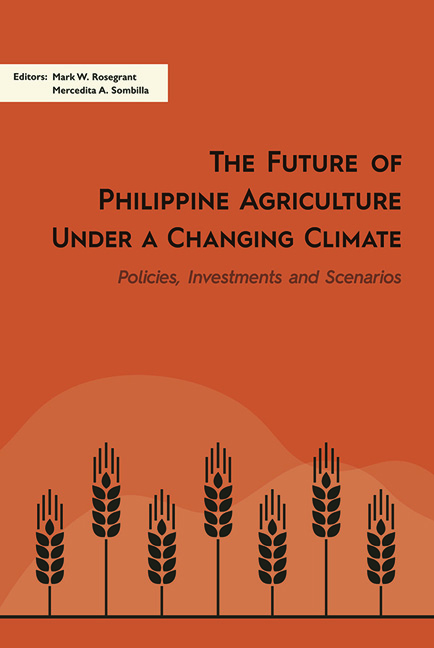Book contents
- Frontmatter
- Contents
- List of Tables
- List of Figures
- List of Appendices
- Preface
- Acknowledgements
- List of Contributors
- PART I Setting up the Scenarios: Current Status and Potential Impacts of Climate Change to Philippine Agriculture
- 1 Current Structure and Future Challenges of the Agricultural Sector
- 2 The Context of Land Cover Changes in Agriculture and Forestry
- 3 Trends in Agricultural Water Resources
- 4 Existing Evidence of Climate Change and Variability
- PART II Climate Change Adaptation Strategies and Sustainability of Philippine Agriculture
- PART III Investments and Supporting Policies to Alleviate Climate Change Impacts to Philippine Agriculture
- PART IV Conclusion
- Index
2 - The Context of Land Cover Changes in Agriculture and Forestry
from PART I - Setting up the Scenarios: Current Status and Potential Impacts of Climate Change to Philippine Agriculture
Published online by Cambridge University Press: 29 May 2019
- Frontmatter
- Contents
- List of Tables
- List of Figures
- List of Appendices
- Preface
- Acknowledgements
- List of Contributors
- PART I Setting up the Scenarios: Current Status and Potential Impacts of Climate Change to Philippine Agriculture
- 1 Current Structure and Future Challenges of the Agricultural Sector
- 2 The Context of Land Cover Changes in Agriculture and Forestry
- 3 Trends in Agricultural Water Resources
- 4 Existing Evidence of Climate Change and Variability
- PART II Climate Change Adaptation Strategies and Sustainability of Philippine Agriculture
- PART III Investments and Supporting Policies to Alleviate Climate Change Impacts to Philippine Agriculture
- PART IV Conclusion
- Index
Summary
The nexus between an increasing global population, the demand for food and the land on which it is cultivated, and emerging climate variability poses one of today's greatest societal challenges (Rudel et al. 2009). Understanding the dynamics and drivers of global land-use change is as important now as ever. As agricultural and pasture lands expand into remaining forests, previously fertile land is lost to desertification and intensified soil degradation. The latest report from the Intergovernmental Panel on Climate Change Fifth Assessment Report (IPCC-AR5) suggests that land-use change may also be responsible for as much as 24 per cent of global greenhouse gas (GHG) emissions (IPCC 2014b). This poses challenges for decision-makers and farmers alike and requires a coordinated effort that balances the need to meet rising food demand with the protection of our fragile and depleted natural resource base. Underpinning this is the need for accurate information on global, regional, national, and subnational dynamics and drivers of land-use change. Increasingly, this needs to be viewed and considered through the lens of climate change.
A tension between two major land-use types — forests and agricultural land — also exists. Prevailing opinion is that expansion of agricultural land comes at the expense of forested areas; indeed, evidence exists suggesting this was, is, and most likely will continue to be one of the major drivers of forest loss and land-use change globally (Rudel et al. 2005; Chomitz 2006; Lambin and Meyfroidt 2011; Hosonuma et al. 2012). This is not necessarily the case in all countries, however, and local contexts are often more complex and ambiguous, as is discussed in this chapter focusing on the Philippines.
Agricultural lands and agroecosystems provide essential benefits to human society and, in addition to being crucial to subsistence and economic activity, are deeply embedded culturally. For developing nations, poorer, often smallholder farmers rely on agriculture to meet their daily needs, and as populations grow so too does demand for land. At the same time, forests also offer benefits to those dependent on their goods and services (who may also be smallholder farmers). Direct benefits such as food, fodder, and timber are obvious. Perhaps less tangible, but no less important, are trees and forests and the role they play in supporting agricultural activities such as micro-climatic regulation, soil nutrient cycling, and stabilization, as well as improving water retention.
- Type
- Chapter
- Information
- The Future of Philippine Agriculture under a Changing ClimatePolicies, Investments and Scenarios, pp. 71 - 132Publisher: ISEAS–Yusof Ishak InstitutePrint publication year: 2018

